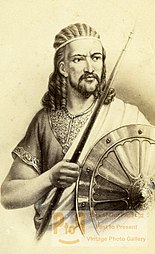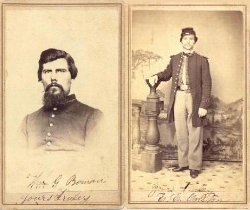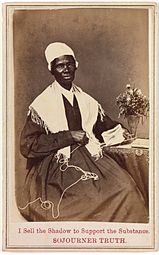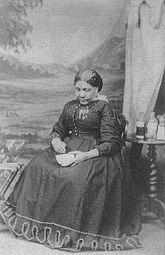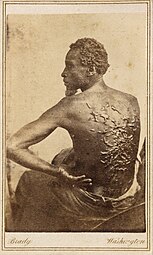
The carte de visite (French: [kaʁt(ə) də vizit(ə)], English: ' visiting card', abbr. 'CdV', pl. cartes de visite) was a format of small photograph which was patented in Paris by photographer André Adolphe Eugène Disdéri in 1854, although first used by Louis Dodero.
Each photograph was the size of a visiting card, and such photograph cards, in an early form of social media, [1] were commonly traded among friends and visitors in the 1860s. Albums for the collection and display of cards became a common fixture in Victorian parlors. The popularity of the format and its rapid uptake worldwide were due to their relative cheapness, which made portrait photographs accessible to a broader demographic, [2] and prior to the advent of mechanical reproduction of photographs, led to the publication and collection of portraits of prominent persons. It was the success of the carte de visite that led to photography's institutionalisation. [3]
History
Format
The carte de visite was usually an albumen print from a collodion negative on thin paper glued onto a thicker paper card. The size of a carte de visite is 54.0 mm (2.125 in) × 89 mm (3.5 in) mounted on a card sized 64 mm (2.5 in) × 100 mm (4 in). The reverse was generally printed with the logo of the photographer or the photography studio from which it came, as protection of copyright, as advertising, and sometimes carried instructions for effective posing. [4]
Camera
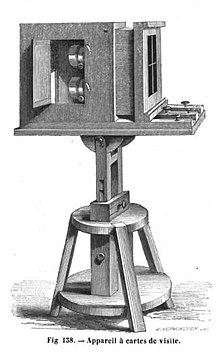


The daguerreotype for portrait photography had met with immediate and widespread popularity and quickly displaced the portrait miniature and its cheaper versions, the silhouette [5] and the physionotrace. [6] However its technologies were limited; a single copy was made in the camera could be reproduced only by copying the original onto another plate. The carte-de-visite provided a wet collodion negative from which could be made multiple prints, in a standardised format, with cheaper materials, thus permitting production on an industrial scale. Consequently it was even more affordable than the daguerreotype. [7]
Special cameras were designed with multiple lenses for their efficient production. Disdéri's 1854 patent was a camera of taking eight separate negatives on a single plate in a special holder. Rather than one large collodion plate being used to produce one image of the posed subject, Disdéri's design initially exposed ten images on one plate, exposed either simultaneously or in sequence.
Each individual carte print was made at a fraction of the cost of producing one full-plate picture and ten were printed at once, saving time and thus efficiently serving the burgeoning consumer market for photography. [8] Disdéri's patent was modified when making four images was found to be more practical, and in March 1860 optician Hyacinthe Hermagis patented a four-lens camera with a sliding back that became the standard. [9] Désiré Monckhoven reported in 1859;
We saw at M. Hermagis' a magnificent device, consisting of 4 identical double lenses mounted on a double frame camera built by M. Besson. This device, in a single operation, provides a plate on which 8 copies of the same image appear with perfect clarity. It seems that in the big cities, such as Paris, London, Berlin, St. Petersburg, these cartes de visite are widely used, so the device we saw at M. Hermagis' enjoys considerable success. [10]
Enlargements
Cartes de visite were made using a contact print—by placing the negative in contact with the albumen paper under glass and exposing the sandwiched materials to a light source. No enlarger was required.
Nevertheless, the development of the solar camera enabled enlargements of cartes up to life-size, often hand-coloured and retouched so that they rivalled the painted portrait, and could be framed and displayed. Prominent London photographer the French-born Antoine Claudet lectured on the technology to the British Association in Oxford in June 1860, and in 1862 presented "On the means of following the small divisions of the scale regulating the distances and enlargement in the solar camera" at the British Association for the Advancement of Science in October. Earlier that year he exhibited a number of life-size portrait enlargements from carte de visite negatives at the 1862 World Fair, which were praised as 'magnificent' and 'without distortion'. [11]
Popularity

France
The carte de visite was slow to gain widespread use until 1859, when Disdéri published Emperor Napoleon III's photos in this format. [9] This made the format an overnight success; as Disdéri was to boast; "Everyone knows how I suddenly became popular by inventing the carte de visite which I had patented in 1854." [12] He charged 20 francs for twelve photographs when previously a single print would cost 50 to 100 francs, so that portraits were suddenly available at a cost that the lower middle classes could afford. [2] The new invention was so popular that "cardomania" [13] spread quickly throughout Europe and then to the rest of the world.
Britain
In England John Jabez Edwin Mayall in Regent Street announced in August 1860 that he had;
...just received the Royal permission to publish a series of portraits which had been previously taken of the Royal family and of several other illustrious personages who have the honour of being intimate friends of her Majesty. These charming portraits are of miniature size; some of them are mounted on cards, and opposite to that of the Queen in the catalogue we find it described as a carte de visite. A complete series is placed upon a screen, in the centre of which are large portraits of his Royal Highness the Prince of Wales in military uniform, and his Royal Highness Prince Alfred in the dress of a midshipman in the Royal navy. Besides the single.figure portraits of the Royal family, there are several most delightful groups of them variously arranged [...] These portraits having been entirely divested of all appearance of Royal state, possess an air of novelty, and the illustrious personages being represented as if perfectly unconscious of the photographer's presence, and engaged in their ordinary occupations, seem to afford the public a legitimate peep into the privacy of the Royal apartments, and give a decided charm to this publication [...] purchasers may, while they have the satisfaction of displaying their loyalty, also have the pleasure of selecting those arrangements of the portraits to which they may give a preference. The whole series, including the personal friends of her Majesty, amounts to 32 portraits, and are very beautiful specimens of the photographic art. [14]
Mayall's publication of a carte-de-visite album of the Royal Family influenced the growing demand from the Victorian public for their own family photographic albums.
Germany
In Germany, Emperor Wilhelm I encouraged this pictorial culture by investing approximately 120 studios with the imprimatur of Hofphotograph (court photographer), based on the cartes that each had made of the kaiser, flatteringly posed with his gloved right fist planted powerfully on a table bearing his plumed helmet, and of his family. Millions of his photographs were collected in German family albums. [15]
India
By the late 1850s the carte-de-visite had been taken up in India, particularly among the wealthy of Bombay. Hurrychind Chintamon was a successful early Indian photographers who made carte-de visite portraits of literary, political, and business figures, the most famous of which was of the Maharaja of Baroda, thousands of which were circulated. [16]
China
While numbers of European photographers visited and practiced in the country, Lai Afong ( Chinese: 黎芳) was a successful Chinese-born photographer who, after working at the studio of Portuguese photographer José Joaquim Alves de Silvieria between 1865 and 1867, established Afong Studio in Hong Kong in the late Qing Dynasty from c.1870, and was photographer to Governor of Hong Kong Sir Arthur Kennedy KCB and Grand Duke Alexei Alexandrovich of Russia. [17] Other Chinese photo studios producing cartes de visite in the 1890s include those of Kung Tai (公泰照相樓)[ citation needed] and Sze Yuen Ming (上洋耀華照相) in Shanghai, [18] [19] and Pun Lun (繽綸) in Hong Kong. [20]
Africa
Frederick York of Cape Town received the first carte-de-visite camera in South Africa as a present from H.R.H. Prince Alfred in February 1861. [21]

United States
The carte de visite was introduced in New York, probably by Charles DeForest Fredricks, late in the summer of 1859 and proved immediately popular in the era of the Civil War. During the war years, photography studios across the country generated hundreds of thousands of carte-de-visite portraits in decorative pressed-paper and tooled-leather albums prized by the soldiers, and their families, thousands of which artefacts survive intact today. [22] As The Times of London reported on August 30, 1862:
America swarms with the members of the mighty tribe of cameristas, and the civil war has developed their business in the same way that it has given an impetus to the manufacturers of metallic air-tight coffins and embalmers of the dead. The young Volunteer rushes off at once to the studio when he puts on his uniform, and the soldier of a year's campaign sends home his likeness that the absent ones may see what changes have been produced in him by war's alarms. In every glade and by the roadsides of the camp may be seen all kinds of covered carts and portable sheds for the worker in metal acid and sun-ray. Washington has burst out into signboards of ambrotypists and collodionists, and the "professors" of New York, Boston, and Philadelphia send their representatives to pick up whatever is left, and to follow the camps as well as they can. [23]
Major studios producing cartes de visite included Brady & Company, Samuel Masury, J. Hall & Company, and N A. & R.A. Moore. [24]
Americans, as with citizens of other countries, were also not only buying photographs of themselves, but also collecting photographs of celebrities. [25] [26]
South America

Portuguese-born Cristiano Júnior in Argentina, [27] and German-born Alberto Henschel [28] and Italian-born photographer Auguste Stahl in Brazil, [29] made carte de visite pictures of “racial types” in the anthropometric genre—standardised poses of naked or semi-naked bodies—of slaves and freed people. [30] As such they were not portraits since they lack any contextual information, or the name of the person; they illustrate contemporaneous biological theories of race being disseminated in Brazil, though not yet widely accepted. Stahl's were shown at the second National Exhibition in 1866. [31] Such cartes de visites were circulated in Brazil between the 1860s and 1880s, as were caste-paintings in late 18th-century Spanish America, [32] but Stahl's were exhibited only once as photographs. Even though praised for their “exceptionally high quality” by the painter Victor Meirelles they were excluded from the Brazilian representation at the London Exhibition of 1862, but at subsequent world's fairs they were present as engraved copies illustrating Swiss-American naturalist Louis Agassiz’ A Journey in Brazil (1868) [33] circulated at the Vienna Universal Exhibition (1873) and the Philadelphia Centennial Exhibition (1876). [29]
Australia
In Australia Manchester-born William Davies began his photographic career with Walter Woodbury (inventor of the Woodburytype) and established several studios in Melbourne from 1858. [34] William Davies and Co at 98 Bourke St., being opposite the Theatre Royal, sold cartes de visite of famous actors, actresses and opera singers. The company also specialised in carte de visite portraits of Protestant clergymen posed as if writing their sermons. [35] The Albury Banner and Wodonga Express of May 1863 finds it noteworthy that "a gentleman had occasion to advertise for a cook. Amongst other applications in answer to his advertisement was one from a "young lady" of the profession, enclosing her carte de visite and stating her salary." [36]
As social media
Now regarded as an early manifestation of "social media", [37] [1] cartes-de-visite were an adjunct to letter-writing; unlike the fragile daguerreotypes which preceded them and which also were used predominantly for portraits, they could be posted in regular manufactured envelopes which had become available only ten years before.
For example, as Belknap notes, Charles Darwin exchanged in his correspondence a large number; 132 photographic portraits before 1882. Their value to him was demonstrated in his response to their gift of an album by Dutch naturalists containing 217 carte de visites; "...for the few remaining years of my life, whenever I want cheering, I will look at the portraits of my distinguish co-workers in the field of science, and remember their generous sympathy. When I die the album will be the most precious bequest to my children." [38]
However, as a Saturday Review, of 1862 notes; "The demand for photographs is not limited to relations or friends. […] Anyone who has seen you, or has seen anybody that has seen you, or knows anyone that says he has seen a person who thought he had seen you, considers himself entitled to ask you for your photograph." [39] [40] [41]
John Ruskin considered a photograph of him taken by William Downey as ʻvisible libelʼ, while Punch illustrator John Tenniel discovered John Watkins selling a portrait of himself that he found unflattering and tried to prevent further sales. Women in particular found themselves vulnerable to having their pictures purchased by 'cads' who would boast that she had gifted them the image and, given the moral standards of the day, discovered their reputations 'tarnished'. [1]
Photographers were in effect publishers, distributing thousands of copies of their images. They would pay a well-known sitter in return for the right to publish their photograph; “the person photographed was offered a flat fee ranging from 25 to 1000 dollars, depending upon notoriety, or a royalty based upon the number of copies sold”. [42] Those whose faces attracted sales, or who already had some incidental notoriety, earned further celebrity and might thus trade on it. However, copyright laws enacted contemporaneously in England protected photographers' rights over those of the subject. [1] [4] Andrew Wynter noted in 1862 that:
"The commercial value of the human face was never tested to such an extent as it is at the present moment in these handy photographs. No man, or woman either, knows but some accident may elevate them to the position of hero of the hour and send up the value their countenances to a degree they never dreamed of." [43]
Demise
By the early 1870s, cartes de visite began to be supplanted by the cheaper tintypes franchised as the "American Gem," and by " cabinet cards" (the term established in Cabinet painting), which were also usually albumen prints, but larger, and mounted on cardboard backs measuring 110 mm (4.5 in) by 170 mm (6.5 in). Nevertheless, while larger framed prints became available at photography studios, the two smaller formats were the main trade of professional portrait photographers even between 1888, when George Eastman introduced the mass produced and pre-loaded Kodak which industrialised the processing and printing of amateurs' photographs, [44] and 1900, when the Brownie camera simplified the technology and so reduced the cost of the medium that snapshot photography became a mass phenomenon.
Gallery of cartes de visite
-
Tewodros II of Ethiopia in the 1860s.
-
Hector Berlioz, c.1864
-
Two photographs taken during the American Civil War. Each soldier shown here served with the 77th Illinois Volunteer Infantry.
-
A later cabinet card of a similar image of Sojourner Truth.
-
One of only two known photographs of Mary Seacole, taken by Maull & Company in London, c.1873.
-
Sim D. Kehoe, who brought Indian-club exercising to the United States from England.
-
Gordon, an enslaved man, reproduced by Mathew Brady.
-
Wilson Chinn, a branded slave from Louisiana—Also exhibiting instruments of torture used to punish slaves
-
A chair presented by Kinman to Abraham Lincoln. Kinman sold cartes-de-visite in the U.S. Capitol.
-
Fridtjof Nansen, Arctic explorer and scientist 1886.
-
An early cat macro by British portrait photographer Harry Pointer, c.1870s.
-
Camille Silvy's portrait of William Fane De Salis, London, 1861.
-
A. Kerpen. Beard 8 feet long, 11 years' growth
-
Rev. Christopher Newman Hall, British clergyman c.1860
-
Elizabeth Thompson, military painter c.1875
See also
References
- ^ a b c d Di Bello, Patrizia (19 March 2013). "Carte-de-visite: the photographic portrait as ʻsocial mediaʼ" (PDF). Understanding British Portraits: Copy, Version and Multiple: the replication and distribution of portrait imagery. – via Seminar: M Shed, Bristol.
- ^ a b Freund, Gisèle (1980). Photography & society (Hardcover ed.). London: D. R. Godine. ISBN 9780879232504.
- ^ Batchen, Geoffrey; Gitelman, Lisa (2019). "Afterword: Media History and History of Photography in Parallel Lines". In Leonardi, Nicoletta; Natale, Simone (eds.). Photography and other media in the nineteenth century (2nd ed.). Pennsylvania: Penn State University Press. p. 197. ISBN 9780271079165. OCLC 1097575379.
- ^ a b Hearn, Alison (2013). ""Sentimental 'Greenbacks' of Civilization": Cartes de Visite and the Pre-History of Self-Branding". In McAllister, Matthew P.; West, Emily (eds.). The Routledge Companion to Advertising and Promotional Culture (hardback ed.). Taylor and Francis. pp. 24–38. ISBN 978 0 415-88801-1.
- ^ Freund, Gisèle (1974), Photographie et société, Éditions du Seuil, p. 8-18, retrieved 18 April 2016
- ^ Cromer 'Le secret du physoniotrace Bulletin de la société archéologique, historique et artistique, ´Le Vieux Papier,' 26th year, October 1925
- ^ Lippert, Amy DeFalco (2018). Consuming Identities: Visual Culture in Nineteenth-Century San Francisco (1st ed.). New York: Oxford University Press. ISBN 9780190268978.
- ^ Sagne, Jean (1998). "All Kinds of Portraits : The photographer's studio". In Frizot, Michel (ed.). A New history of photography (1st English ed.). Köln: Könemann. p. 102. ISBN 9783829013284.
- ^ a b Plunkett, John (2013-12-16). "Carte-de-visite". In Hannavy, John (ed.). Encyclopedia of Nineteenth-Century Photography. Routledge. pp. 276–277. doi: 10.4324/9780203941782. ISBN 978-0-203-94178-2.
- ^ van Monckhoven, Desirée (1859). Répertoire général de photographie pratique et théorique contenant les procédés sur plaque, sur papier, sur collodion sec et humide, sur albumine etc (in French) (3rd, avec atlas composé de dix planches ed.). Paris: A. Gaudin et frère. p. 596. OCLC 476794826.
- ^ The Morning Post, Sat, April 19, 1862, p.5
-
^ Disdéri, André-Adolphe-Eugène (1862). L'art de la photographie (1st ed.). Paris.
{{ cite book}}: CS1 maint: location missing publisher ( link) - ^ Newhall, Beaumont (1980). Photography: essays and images: illustrated readings in the history of photography (1st ed.). London: Martin Secker. ISBN 9780436305061. OCLC 819771024.
- ^ "Fine Arts: Mr Mayall's Photographic Exhibition". Morning Herald. London. 16 August 1860. p. 6.
- ^ Zervigón, Andrés Mario (2017). Photography and Germany (1st ed.). United Kingdom: Reaktion Books. p. 61. ISBN 9781780237947.
- ^ Sandler, Martin W. (2002). Photography: an illustrated history. USA: Oxford University Press. p. 32. ISBN 9780195126082.
- ^ Farmer, Hugh. "Lai Afong 赖阿芳 and Afong Studio, early HK photographic studio". The Industrial History of Hong Kong Group. Retrieved 2 September 2020.
- ^ "Sze-yuen Ming 上洋耀華 – The Chinese studio Sze Yuen Ming & Co was known in Chinese as Yao Hua studio. This studio based in Shanghai and active between 1892 and the 1920s was directed by Shi Dezhi". photographyofchina.com. Retrieved 2023-05-16.
- ^ "Sze Yuen Ming (Yao Hua) Studio | Historical Photographs of China". hpcbristol.net. Retrieved 2023-05-16.
- ^ "缤纶工作室/Pun Lun Studio". 百年影像 (in Chinese (China)). 2020-04-11. Retrieved 2023-05-16.
- ^ "South African "Cartomania" – a photographic phenomenon | The Heritage Portal". www.theheritageportal.co.za. Retrieved 2023-05-13.
- ^ Rosenheim, Jeff L. (2013). Photography and the American Civil War (Paperback ed.). United Kingdom: Yale University Press. ISBN 9780300191806.
- ^ "American Photographs". The Times. 30 August 1862. p. 27.
- ^ Weling, William (1987). Photography in America : The Formative Years 1839–1900 (Reprint ed.). Albuquerque, NM: University of New Mexico Press. ISBN 9780826309532.
- ^ Schweitzer, Marlis; Zerdy, Joanne (2014-08-14). Performing Objects and Theatrical Things. Springer. ISBN 978-1-137-40245-5.
- ^ Volpe, Andrea L. (2001). "Cartes de Visite and the Culture of Class Formation". In Bledstein, Burton J.; Johnston, Robert (eds.). Middling Sorts: Explorations in the History of the American Middle Class. New York: Routledge. pp. 157–169.
- ^ Moritz Schwarcz, Lilia (2006-04-15). "A Mestizo and Tropical Country: The Creation of the Official Image of Independent Brazil". European Review of Latin American and Caribbean Studies (80): 25. doi: 10.18352/erlacs.9653. ISSN 1879-4750.
- ^ Hannavy, John, ed. (2013-12-16). Encyclopedia of Nineteenth-Century Photography. Routledge. doi: 10.4324/9780203941782. ISBN 978-0-203-94178-2.
- ^ a b Schuster, Sven (July 2015). "Envisioning a 'Whitened' Brazil: Photography and Slavery at the World's Fairs, 1862–1889". Estudios Interdisciplinarios de America Latina y el Caribe. 26 (2): 17–41.
- ^ Prussat, Margrit (2015-12-31), Fischer, Manuela; Kraus, Michael (eds.), "Carte de visite photography in South America. The mass-produced portrait", Exploring the Archive, Köln: Böhlau Verlag, pp. 129–150, doi: 10.7788/9783412218423-005, ISBN 978-3-412-22415-8, retrieved 2023-05-16
- ^ dos Reis, José Maria (1866). Catalogo dos Instrumentos de Optica e Scientificos apresentados à Exposição Nacional Brasileira pelo establecimento de José Maria dos Reis (in Portuguese). Rio de Janeiro: Typographia do Commercio de Pereira Braga. p. 6.
- ^ Silver, Carly (2020-10-10). "The Paintings That Tried (and Failed) to Codify Race". JSTOR Daily. Retrieved 2023-05-16.
- ^ Agassiz, Louis; Agassiz, Elizabeth Cabot Cary (1869). A journey in Brazil. LuEsther T. Mertz Library New York Botanical Garden. Boston : Ticknor and Fields.
- ^ Cato, J. (1955). The Story of the Camera in Australia (1st ed.). Georgian, Melbourne.
- ^ "Davies & Co". Art Gallery of New South Wales. Retrieved 2023-05-13.
- ^ "Victorian News". Albury Banner And Wodonga Express Newspaper Archives May 23, 1863 Page 4. 23 May 1863. p. 4.
- ^ Rudd, Annie (2016). "Victorians Living in Public: Cartes de Visite as 19th-Century Social Media". Photography and Culture. 9 (3): 195–217. doi: 10.1080/17514517.2016.1265370. S2CID 193760648.
- ^ Belknap, Geoffrey (2018). "Photographs in Text: The Reproduction of Photographs in Nineteenth-Century Scientific Communication". In Leonardi, Nicoletta; Natale, Simone (eds.). Photography and Other Media in the Nineteenth Century (1st ed.). United States: Penn State University Press. p. 142. ISBN 9780271079158.
- ^ Anon (1862). "Fashions". Saturday Review.
- ^ Helmreich, Anne (2010-09-08). "Anne Helmreich. Review of "Playing with Pictures: The Art of Victorian Photocollage" by Elizabeth Siegel". Caa.reviews. doi: 10.3202/caa.reviews.2010.98. ISSN 1543-950X.
- ^ Hofelt, Miranda; Siegel, Elizabeth; Di Bello, Patrizia; Weiss, Marta Rachel (2009). Playing with Pictures: The Art of Victorian Photocollage. United Kingdom: Art Institute of Chicago. p. 20. ISBN 9780300141146.
- ^ Darrah, William C. (1981). Cartes de Visite in Nineteenth Century Photography. Gettysburg, PA: W. C. Darrah Publishing. p. 43. ISBN 9780913116050. OCLC 8012190.
- ^ Wynter, Andrew (1862). "Cartes De Visite". The Living Age: 72.
- ^ Riches, Harriet (2015). "Picture Taking and Picture Making: Gender Difference and the Historiography of Photography". In Sheehan, Tanya (ed.). Photography, history, difference. Interfaces, studies in visual culture. Hanover, New Hampshire: Dartmouth College Press. p. 131. ISBN 9781611686463. OCLC 880122479.
External links
The examples and perspective in this article may not represent a
worldwide view of the subject. (May 2023) |
- Portraits of Scientists: Increase Lapham's Cartes-de-visite Collection Collected by pioneering Wisconsin antiquarian Increase A. Lapham between 1862–75, this album of carte-de-visite photographic portraits depicts many notable 19th-century scientists from America and Europe. Available on Wisconsin Historical Images, the Wisconsin Historical Society's online image database.
- University of Washington Libraries Digital Collections – 19th Century Actors Photographs Cartes-de-visite studio portraits of entertainers, actors, singers, comedians and theater managers who were involved with or performed on the American stage in the mid-to-late 19th century.
- William Emerson Strong Photograph Album – Duke University Libraries Digital Collections 200 cartes de visite depicting officers in the Confederate Army and Navy, officials in the Confederate government, famous Confederate wives, and other notable figures of the Confederacy. Also included are 64 photographs attributed to Mathew Brady.
- Southern Cartes de Visite Collection, A.S. Williams III American Collection, Division of Special Collections, University of Alabama Libraries. Over 3300 digitized cartes de visite, the majority of them from southern studios.
- The Carte de Visite file at the New-York Historical Society
- Cartes de Visite of California photographers Archived 2013-08-19 at the Wayback Machine at Beinecke Library via flickr
